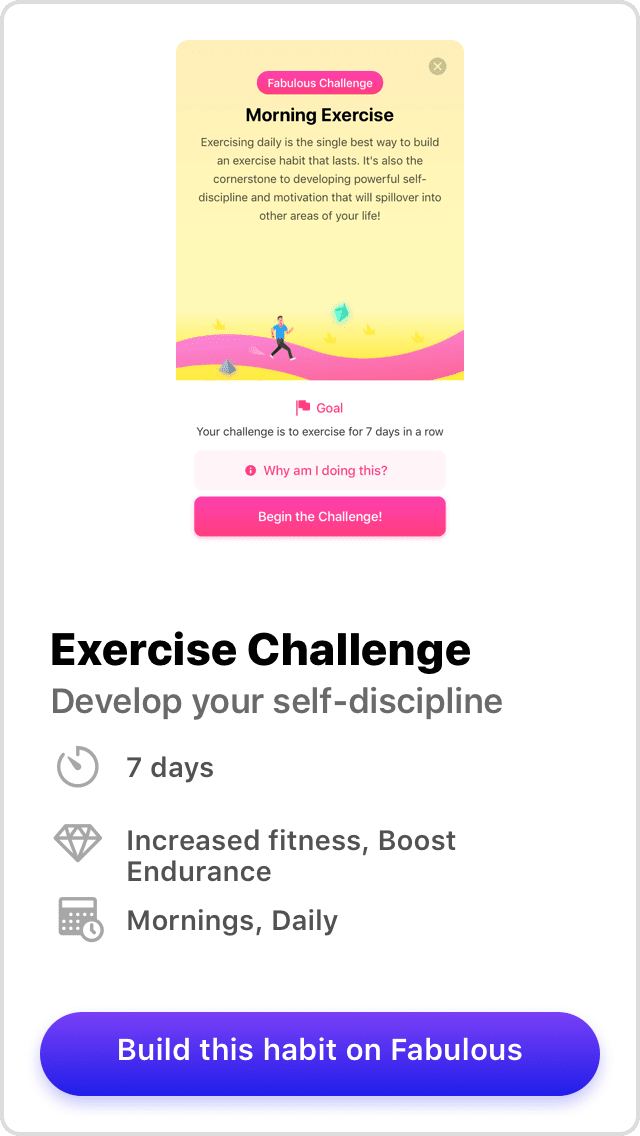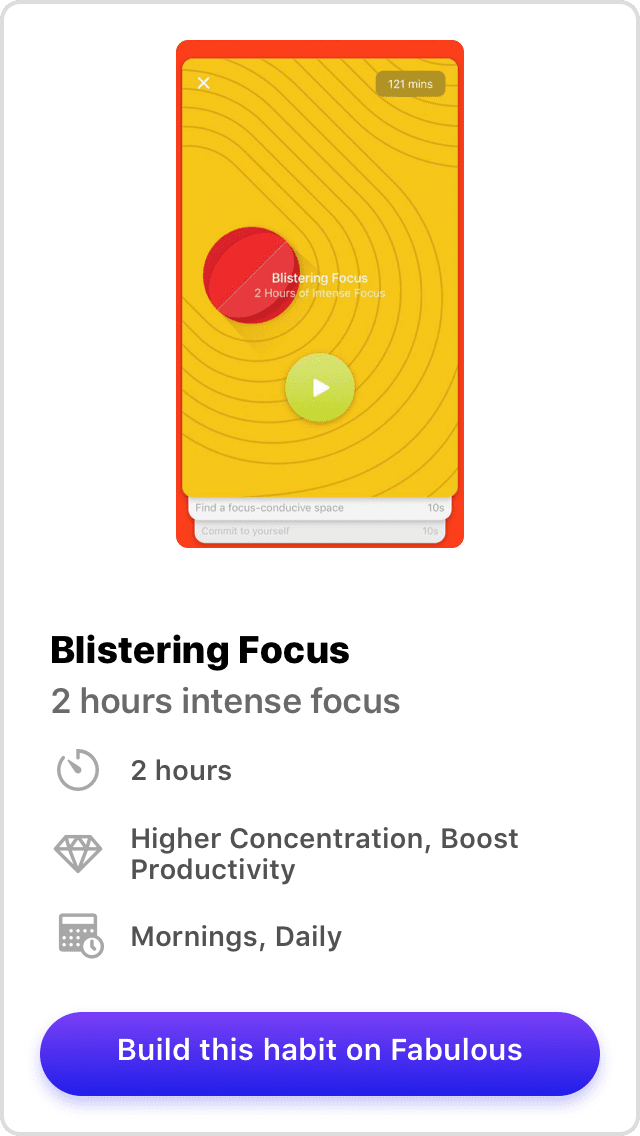James Clear has dedicated much of his life to studying the psychology of habits. In his book Atomic Habits, he explains that the secret to changing your behavior for the long-term is not about sudden, sweeping changes. It’s instead about making small, incremental changes to your lifestyle. Not only is it easier to do, you’re more likely to stick with those changes for life.
Fabulous also believes that making small changes is the most effective way to grow positive long-term behaviors. Like the atoms that make up all matter, it’s our small habits that make up who we are.
The Four Components of a Habit
Normally, when we talk about what makes up a habit here at Fabulous, we say a habit is composed of three parts. In his book, Clear expands this to four:
Cue
A habit cue can be anything: a smell, a feeling, or even a time of day. The cue is a signal to your brain that there is a potential reward to be had. For example, if you walk into your kitchen and smell freshly-baked cookies, that is a cue to your brain that a delicious treat is on the horizon. A cue can also be more subtle; walking into a dark room, for example, might be a cue to turn on a light.
Craving
Once you’ve received your cue, the craving starts. Your brain has established that you could potentially be rewarded (in this case, with fresh cookies) and so it begins to seek out the reward and determine the means to obtain it. In the case of our example, your mouth will likely start to water and you’ll begin to wonder if anyone will notice a missing cookie or two.
Response
The response comes once you’ve decided how to act on your craving. This response is automatic; that is, you do it without thinking. In the case of our cookie example, your automatic response might be to hunt those cookies down and help yourself. Or, if you’re on the Fabulous healthy eating journey and are trying to watch your intake of sweets, you might respond by avoiding the kitchen or getting a healthier snack instead.
Reward
The final step of a habit is the reward. You likely wouldn’t follow through with your habits if you didn’t reap some kind of reward from them! Rewards, like cues, can be anything. They bring you satisfaction or pleasure as a result of your actions and incentivize you to do the same thing the next time you receive your cue. In the case of our cookie example, if your response is to eat a cookie, it should go without saying that the cookie itself is the reward!
How to Develop a New Habit
Clear’s book explains that much of behavior change is approached from the wrong angle. People tend to focus on the goals they want to achieve rather than the systems they intend to implement to make that change. Goals are a great way to point you in the right direction and keep you on the right path. It’s the system, however, that matters most when it comes to actually changing your behavior.
Atomic Habits outlines four “behavior laws” to implement systems that will lead to real change, using the four parts of a habit as scaffolding.
Make it Obvious.
Ever heard the phrase, “The squeaky wheel gets the grease?” We do the things that are obvious to us. Designing your environment around the habits you want to build can create cues you need to complete the habit. For example, if you want to make a habit of going for a morning run, you could lay your running clothes out before going to bed, so you see them first thing in the morning.
Make it Attractive.
Do you know why the Fabulous app uses so many bright colors and pleasing illustrations? It’s to incentivize you to open the app and use it regularly! In other words, Fabulous is creating a craving. You can apply this principle to other habits you want to develop. If you want to drink more water, buy a water bottle you love. It’ll make you want to reach for it when you’re thirsty!
Make it Easy.
No one wants to think hard about every choice they have to make. In fact, each decision you have to make spends a portion of your mental energy. Overspending can lead to “decision fatigue,” which may result in seeking out shortcuts for relief, like buying fast food instead of cooking your own meals. By making your healthy habits easy, you can do them without thinking too hard about it. If you’re doing one of Fabulous’s deep work
Make it Satisfying.
Remember, you won’t want to complete your habit if it’s not rewarding! That’s why Fabulous has a “celebrate” habit built right into it. We want you to celebrate your achievements, because we know that means you’ll do them again next time! Be sure to always reward your good behavior in whatever way is meaningful to you. But also be sure the reward doesn’t negate the habit; rewarding a healthy lunch with a big dessert would be a bit counter-productive, for example.
Breaking a Bad Habit
Implementing systems that will help you complete your habits can make it easier to build good ones. But what about breaking bad habits? The process is luckily not that different. In fact, all you have to do is the opposite series of steps required to build a habit. So, if you want to break a habit, you’ll want to make it invisible, unattractive, difficult, and unsatisfying.
Let’s look at another example. Say you want to quit smoking cigarettes. To make the habit invisible, you could hide your cigarettes and lighters, or get rid of them entirely. Looking up research on the negative effects of cigarette smoking might make it more unattractive. To make it more difficult, you might designate only certain times or places to smoke, such as outside in the cold. Finally, you could make smoking unsatisfying by buying cigarettes you don’t like, or coating the filters with something that tastes unpleasant to you, like a spicy hot sauce or a bitter herbal tincture.
Going Forward
Whether you’re planning to build new habits or break old ones, Clear recommends tracking your habits. Doing so will help you understand what’s working and what isn’t. Plus, once you’ve got a chain of successful habit completion going, you won’t want to break it!
To start building new habits using the Clear method, download Fabulous for free today. By making small, incremental changes to your everyday habits, you’ll slowly build a healthy lifestyle that isn’t a struggle to maintain. In fact, it’ll be second nature!






